Class 120 Swindon 3-car DMUs
Operations - Scotland 1958 to 1981
Allocation changes
28/11/59
51781 - New to 61A
51782 - New to 61A
51783 - New to 61A
05/12/59
51784 - New to 61A
51785 - New to 61A
12/12/59
51786 - New to 61A
51787 - New to 61A
19/12/59
59679 - New to 61A
59680 - New to 61A
26/12/59
59681 - New to 61A
59682 - New to 61A
02/01/60
59683 - New to 61A
59684 - New to 61A
09/01/60
51788 - New to 61A
59685 - New to 61A
16/01/60
51789 - New to 61A
23/01/60
51790 - New to 61A
51791 - New to 61A
13/02/60
51792 - New to 61A
20/02/60
51793 - New to 61A
51794 - New to 61A
Feb-60
51787 - Transferred to 66C
51788 - Transferred to 66C
59681 - Transferred to 66C
3w/e 02/04/60
51784 - Transferred to 66C
51786 - Transferred to 66C
51790 - Transferred to 66C
51791 - Transferred to 66C
59682 - Transferred to 66C
59685 - Transferred to 66C
2w/e 09/04/60
51782 - Transferred to 66C
51783 - Transferred to 66C
51785 - Transferred to 66C
51789 - Transferred to 66C
51792 - Transferred to 66C
51794 - Transferred to 66C
59679 - Transferred to 66C
59683 - Transferred to 66C
59684 - Transferred to 66C
4w/e 04/06/60
51785 - Transferred to 61A
51786 - Transferred to 61A
51789 - Transferred to 61A
51790 - Transferred to 61A
59684 - Transferred to 61A
59685 - Transferred to 61A
4w/e 18/06/60
51782 - Transferred to 61A
51794 - Transferred to 61A
59683 - Transferred to 61A
Jun-60
51784 - Transferred to 61A
51791 - Transferred to 61A
59682 - Transferred to 61A
Jul-60
51782 - On loan to 60A
51794 - On loan to 60A
59683 - On loan to 60A
3w/e 19/11/60
51781 - Transferred to 64H
51784 - Transferred to 64H
51786 - Transferred to 64H
51790 - Transferred to 64H
51791 - Transferred to 64H
51793 - Transferred to 64H
59680 - Transferred to 64H
59682 - Transferred to 64H
59685 - Transferred to 64H
3w/e 17/12/60
51782 - Ex-loan back to 61A
51794 - Ex-loan back to 61A
59683 - Ex-loan back to 61A
w/e 03/06/61
51781 - Transferred to 61A
51784 - Transferred to 61A
51786 - Transferred to 61A
51790 - Transferred to 61A
51791 - Transferred to 61A
51793 - Transferred to 61A
59680 - Transferred to 61A
59682 - Transferred to 61A
59685 - Transferred to 61A
4w/e 24/06/61
51783 - Transferred to 61A
51787 - Transferred to 61A
51788 - Transferred to 61A
51792 - Transferred to 61A
59679 - Transferred to 61A
59681 - Transferred to 61A
2w/e 12/05/62
51781 - Transferred to 66C
51790 - Transferred to 66C
59685 - Transferred to 66C
Sep-62
51781 - Transferred to 67A
51790 - Transferred to 67A
59685 - Transferred to 67A
3w/e 03/11/62
51787 - Transferred to 67A
51788 - Transferred to 67A
59681 - Transferred to 67A
4w/e 01/06/63
51781 - Transferred to 61A
51790 - Transferred to 61A
59685 - Transferred to 61A
3w/e 30/04/66
51787 - Transferred to 66C
51788 - Transferred to 66C
59681 - Transferred to 66C
4w/e 31/12/66
51785 - Transferred to 67A
51787 - Transferred to 67A
51788 - Transferred to 67A
51789 - Transferred to 67A
59681 - Transferred to 67A
59684 - Transferred to 67A
Jan-67
51781 - Transferred to 60A
51782 - Transferred to 60A
51783 - Transferred to 60A
51784 - Transferred to 60A
51786 - Transferred to 60A
51790 - Transferred to 60A
51791 - Transferred to 60A
51792 - Transferred to 60A
51793 - Transferred to 60A
51794 - Transferred to 60A
59679 - Transferred to 60A
59680 - Transferred to 60A
59682 - Transferred to 60A
59683 - Transferred to 60A
59685 - Transferred to 60A
4w/e 02/09/67
51787 - Transferred to 60A
51788 - Transferred to 60A
59681 - Transferred to 60A
2w/e 13/01/68
51785 - Transferred to 60A
51789 - Transferred to 60A
59684 - Transferred to 60A
4w/e 30/06/68
51781 - Transferred to 66C
51789 - Transferred to 66C
59685 - Transferred to 66C
Oct-68
51781 - Transferred to 60A
51789 - Transferred to 60A
4w/e 05/07/69
51787 - Transferred to 66C
51791 - Transferred to 66C
59680 - Transferred to 66C
Aug-69
51781 - Transferred to 66C
51787 - Transferred to 60A
51788 - Transferred to 66C
51791 - Transferred to 60A
59680 - Transferred to 60A
59684 - Transferred to 66C
59685 - Transferred to 60A
4w/e 01/11/69
51781 - Transferred to 60A
51788 - Transferred to 60A
59684 - Transferred to 60A
w/e 04/07/70
51781 - On loan to 66C
51788 - On loan to 66C
59684 - On loan to 66C
Sep-70
51781 - Ex-loan back to 60A
51788 - Ex-loan back to 60A
59684 - Ex-loan back to 60A
Jun-78
51784 - Stored U. ZC
4w/e 01/03/80
51787 - Transferred to AY
51789 - Transferred to AY
59685 - Transferred to AY
2w/e 22/03/80
51781 - Transferred to CF
51782 - Transferred to CF
51783 - Transferred to CF
51785 - Transferred to CF
51788 - Transferred to CF
51790 - Transferred to CF
51792 - Transferred to CF
51793 - Transferred to CF
59681 - Transferred to CF
59682 - Transferred to CF
59683 - Transferred to CF
59684 - Transferred to CF
Mar-80
51794 - Transferred to AY
59680 - Transferred to AY
2w/e 10/05/80
51786 - Transferred to CF
51791 - Transferred to CF
59679 - Transferred to CF
18/12/80
51784 - Withdrawn
05/10/81
51787 - Transferred to DY
51789 - Transferred to DY
51794 - Transferred to DY
59680 - Transferred to DY
59685 - Transferred to DY
The second batch of vehicles (51781-7, 59679-85, 51788-94) were for many years associated with the Aberdeen to Inverness line, and until 1970 were also used on summer services to Oban.
Tests

The vehicle transfers as they appeared in the 9/58 Scottish Region edition of the British Railways Magazine under the period five weeks ending 26/7/58.
In the summer of 1958 a 3-car set with buffet, was loaned to the ScR from the WR and operated experimentally for a few weeks between Aberdeen and Inverness.
Beginning on the 28th July, W50676 / 59283 / 50720 ran on the 7.47am (or 8.05?) Aberdeen to Inverness and 12.45 return. The ScR distributed questionnaires to gain the views of passengers, particularly those who lived or worked between the two cities. A senior BR representative traveled on the train daily to discuss the diesel service with passengers and find out their reactions.

The photo shows the set in Inverness station ready to work the 12.45pm to Aberdeen in late July 1958. The set was borrowed from the Western Region for a few weeks for trials. Image courtesy of the Great North of Scotland Railway Association.
Land Cruise
On Wednesday 6th August the set worked an evening land cruise from Aberdeen at 7.15pm to Keith & back, giving other members of the public an opportunity to travel on this type of train. The buffet was open serving light refreshments.[1]
Oban
On Monday and Tuesday August 11th/12th 1958 the set ran to Oban, to see if this type of unit could in due course provide the passenger services on the Oban branch. Again, a questionnaire was organised and a representative carried. The set operated the 11.40am from Edinburgh Princes St, which united with Met Camms 51231 / 56389 and 56406 / 51248 at Stirling, which were the 12.00 noon from Glasgow Buchanan Street. The return working was the 5.15pm from Oban, splitting at Stirling. The 3-car set was noted as arousing widespread public interest.
The set then returned to Cardiff by the end of August.
New Vehicles
On paper all of the twenty-one vehicles (seven sets) from the second build were delivered to Aberdeen's 61A Kittybrewster depot between November 1959 and January 1960. As was the norm with vehicles built at Swindon the vehicles were not delivered as sets. The DMBCs came first, followed by the centre cars, the DMSs were last. Between February and April 1960 six sets were transferred to 66C Hamilton, leaving just one set (51781/59680/51793) at Kittybrewster.
Hamilton 1960
Amongst the workings they did from Hamilton included the many 'Land Cruise' diesel train excursions. Two sets worked the Largs and Ayr Land Cruise from Queens Park on Monday 18th April 1960[2]. A few weeks later on the 14th May, a set was noted in the bay at Callander, possibly on a 'Six Lochs Land Cruise' tour. Sets worked the Six Lochs tours on the 18th[3] and 19th May[4].

The image shows an Oban bound excursion on the 17th May. This was formed of two sets from Glasgow Queen Street to Crainlarich Upper where the train divided, one set going to Fort William, the other to Oban. The passengers would do a circular tour, half in each direction, travelling between the two railway termini by steamer over Loch Linnhe. Michael Mensing.
Aberdeen - Inverness Announcement
In mid-June 1960 the Scottish Area Board of the BTC announced at a special meeting in Aberdeen that diesel multiple units would be introduced between Aberdeen and Inverness from July 1st 1960 to test the demand for a high-speed service between the cities.
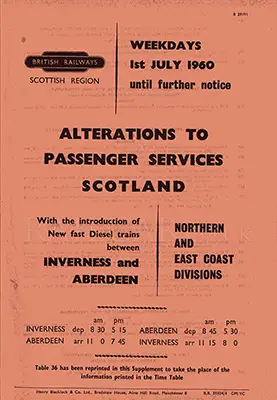
The 108 mile journey would have a time of 2 1/2 hours with four stops, at Nairn, Forres, Elgin and Keith Junction. The previous best timing was 3 hours 18 minutes (with 13 stops!). There were to be two DMU services in each direction, leaving Aberdeen at 8.45am and 5.30pm, and Inverness at 8.30am and 5.15pm. Cheap day return fares were introduced to stimulate tourist traffic. The timings allowed a full day in either city without starting too early in the morning or getting back too late at night. Timings from Nairn were 25 mins to Inverness and 130 mins to Aberdeen, from Forres to Inverness it took 40 mins, to Aberdeen 115 mins, from Elgin it was 58 mins to Inverness and 98 mins to Aberdeen, and to Inverness from Keith was 81 mins and Aberdeen was reached in 70 mins.
A timetable alteration was issued which mentioned the 'New fast Diesel trains' on the cover (pictured). It was a tri-fold brochure: side one; side two. Scans courtesy of Mike Cooper.
Colonel Donald H. Cameron of Locheil, Chairman of the Board also stated at the meeting that if successful the trains would be re-introduced the following year.
Services Start
To operate the services four sets were transferred back north, three - 51784-6 + 59682/4/8 + 51789-91 - to Kittybrewster, the fourth went on loan to 60A Inverness (51782/59683/51794). Two formations were required for traffic, this allowed six-car sets to be used if needed with one spare.
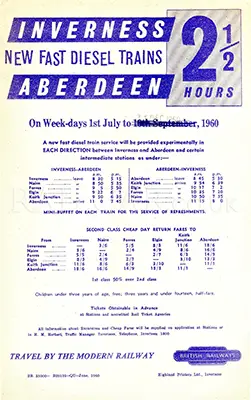
A special handbill was produced to promote the new trains, pictured, scan courtesy of John Horne.
Although originally introduced as an experimental summer service till the 10th September, the success of the trains, with their mini-buffets selling light refreshments, saw them extended till the end of the year to test the demand outside the summer months. Note the amended date on the handbill.
That August (1960) a traffic survey showed that a large portion of the passengers were tourists or locals on holiday, but it was hoped that the existence of the fast service in winter, when motoring in north-east Scotland could be unpleasant and dangerous, would attract business and local residents who would otherwise have traveled by other means.

This scheme was extended again till the end of the winter 1960/1 timetable (till June 10th 1961), and the sets were gaining a good reputation for punctuality - during March 1961 this was recorded as 98%. The image shows the 8.45am Aberdeen to Inverness leaving Keith on the 31st March 1961. Hamish Stevenson.
By the end of 1960 The set on loan to Inverness was returned to Kittybrewster.
Edinburgh
Three sets moved south to Leith Central depot in November 1960 where they were noted on Edinburgh - Glasgow services, and near the end of their time there one set spent ten days on the Fife diesel services with the buffet out of use. This image of a set at Edinburgh should be one of these three Leith sets, they returned to Kittybrewster on the week ending 3 June 1961.
The extended trials between Aberdeen and Inverness were obviously a success, as from the next timetable on the 12th June 1961 the ScR doubled the number of DMU expresses to four daily each way. For these extra service all the sets were allocated to Kittybrewster. It was hoped that they would attract more businessmen and tourists to the north-east of Scotland. Some services had an additional stop added at Huntly, although the 2 1/2 hr timing was maintained. There were improved connections with the south at Aberdeen and north at Inverness, and the timings would allow a businessman an afternoon in Inverness before returning to Aberdeen at 5.30pm. The fares were increased from 18s 6d to 24s, quite a jump, although the new rate worked out as 1.17d a mile (up from 1.05d a mile) which was still very low and the passengers were getting fast clean and comfortable trains with snack meals available.
The services now left Aberdeen at 7.50am, 11.45am, 1.50pm and 6.00pm, and Inverness at 8.30am, 10.45am, 2.30pm and 5.30pm. The westbound 7.50am and 1.50pm and eastbound 10.45am and 5.30pm stopped additionally at Huntly.
The sets made use of a tablet catcher fitted the guard's van door on either side, the only DMUs to have such a feature. The mechanisms made it impractical to have these in the driving cab. After exchanges the Guard would confirm to the driver by buzzer that the correct tablet was on board. It was not unknown for the exchange to fail, requiring a hurried stop and a walk back down the tracks to find the tablet.

They would work other services other than Aberdeen - Inverness, and this video clip was taken on board a set working between Buckie and Tillynaught. They were not unknown to reach St Combs, as seen the image circa 1960. Eric Stuart.
The handbill promoting the Inverness - Aberdeen diesel services continued to be issued at intervals. These cover the late 1961 - June 1963 period, scans courtesy of John Horne:
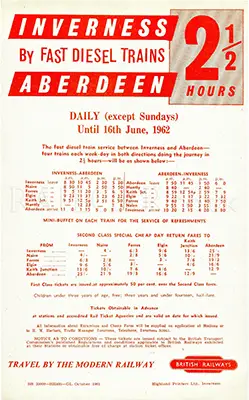
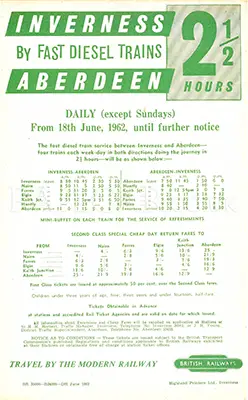
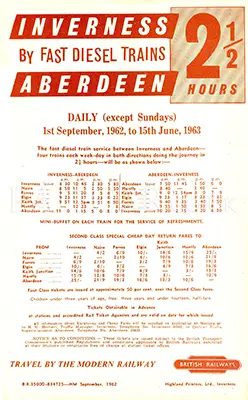

In the next image Sc51783 leads the 2.30pm Inverness - Aberdeen service at Inveramsay, being worked by a 6-car Swindon Cross-Country formation on 14/7/64. Michael Mensing.
There is a photo feature showing the sets on the Aberdeen - Inverness line.
Oban
In the Summer of 1962 there was a new Oban Tourist Train on Mondays - Fridays. It was operated by Class 120s and ran from the 18th June till the 7th September. It took the route via Loch Lomond, the normal service train ran via Callander.
It departed / returned at the following times:
Glasgow Queen Street 9.35am - 8.30pm
Craigendoran 10.10am - 7.48pm
Crainlarich Upper 11.20am - 6.41pm
Loch Awe 11.57am - 6.01pm
Connel Ferry 12.31pm - 5.29pm
Oban 12.50pm - 5.15pm
The buffet car was operational, and the service was also known as the "Oban Flyer". The Lord Provost of Glasgow, Mrs Jean Roberts, and her husband, Mr Cameron Roberts, travelled on the first train from Glasgow. At Oban Provost Neil Cameron and Mr JG Mathieson, County Convener, greeted the party.
As well as giving the choice of viewing some of Scotland’s most scenic granduer from the windows of the three-coach multiple unit train, the passengers would get to Oban in 3 hours 15 mins, the quickest ever time. The previous fastest time from Glasgow to Oban was 3 hours 32 minutes (a Saturday only service), and the regular time taken to travel to Oban by train was 4 1/2 hours.
Accompanying the Lord Provost on the train were Mr R.A. Long, Asst. General Manager BR-Scotland, Mr R.B. Reid, District Passenger Manager, Glasgow, and Mr W.A. Nicholson, Manager and Secretary of the Scottish Tourist Board.
A souvenir brochure was produced for the "New Diesel Tourist Train" which described the sights to be seen on the journey, with the timetable inside. The cover and first set of pages are shown, scans courtesy of John Paton.
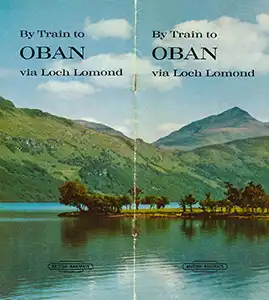

51781/59685/51790 had been transferred to Hamilton to work this service, and when it came to an end in September the set moved to Corkerhill. It was joined there in October by 51787/59681/51788. From there they would work on some of the South Glasgow routes such as to Kilmarnock. 51781/59685/51790 would return to Kittybrewster in May 1963, 51787/59681/51788 remained at Corkerhill until moving to Hamilton in April 1966.
In 1963 photos show that a "Glasgow - Oban" sideboard was carried, and still being carried in 1965. In July 1966 one of these working was noted as a hyrid set formed 101 DMBS / 120 TSB / 120 DMC. Other forays onto the West Highland line were to Mallaig, when a 3-car set made a test run north on the 19th October 1966, and south the following day. BR used the trip to produce a performance curve for the DMU on the line.

The Oban summer service continued annually usually using Class 120s until 1970. The image shows a set in Oban station that year, presumed to be 51788/59684/51781 as that was the set on loan to Hamilton at the time. Mike Cooper Collection.
The summer Oban service would then normally use Eastfield Class 101s, until at least 1975 when the prototype refurbished Met-Camm unit was used.
Aberdeen - Inverness
On this line tail traffic was far from unusual, nor was the attachment of a Class 122 when they were allocated to Inverness. The five Kittybrewster sets were transferred to Inverness depot in January 1967 (the other two sets were at Corkerhill). Kittybrewster closed later that year, and when at Aberdeen they would now be serviced and stabled at Ferryhill depot.
Scottish DMUs differed from the rest of the country by laterly receiving yellow stripes for first class while still in green livery. When corporate blue arrived the ScR decided to paint the Class 120 units plain blue unlike the rest of the Class 120 fleet which (after a brief spell in plain blue for some) became blue/grey.
The two Corkerhill sets moved to Inverness, one in August 1967 and one in January 1968. This was the first time that Inverness had the full complement of seven sets.
In 1968 the Aberdeen-Inverness services were recast to be exclusively DMU operated, requiring all seven-sets. The summer timetable involved some six-car diagrams but with one power car in works for overhaul Inverness did not have enough vehicles[5]. Two two-car GRC&W Cross-Country sets had arrived at Inverness in late April but were found to be unsuitable and stored.
Mid-1968 was also a period when modification work was being done to the sets, with 51786 converted to a DMBF at Inverurie (works date 4-6-68) - presumably the other three conversions were done around the same time. Stretcher windows were fitted to three DMSs in Glasgow Works - 51791 on 12-4-68, 51792 on 31-5-68 and 51793 (also a C5) 1-5-68 - the date for 51790 is unknown.
In June 1968 51781/59685/51789 were transferred to Hamilton for the summer Oban service. In August a three-car Met-Camm set (51464/59562/51534) arrived from Hamilton to make up for the shortage, it stayed at Inverness until March 1970. It can be seen in the second image as part of a nine-car formation.
Curiously, allocation changes show that 51781/9 returned to Inverness from Hamilton in October 1968 without centre car 59685. It returned when the Oban set at Hamilton was swapped in August 1969.
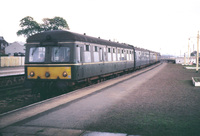
The image shows two sets arriving into Inverurie on 12 August 1969. The leading car has lost its coaching crest - is it painted over? The closest centre car and at least the first car of the second set are in blue. David Mant.
Inverness had another Met-Camm (a three-car TBS set) on loan from June to September 1970 - this being a swap with Hamilton for 51781/59684/51788 to work that seasons Oban service.

The image shows a set departing Aberdeen for Inverness during the demolition of the platform canopies and north footbridge in February 1973. John McIntyre.
In 1977 the blue / grey livery started to appear when the sets began to be refurbished.
Inverness had some single car Class 122s and there were often found substituting for the Swindon power cars, particularly in the 1977/8 period.

On the 12th May 1978 a road vehicle hit a railway bridge at Oyne, knocking it out of alignment. The first train past was the 07:43 from Aberdeen to Inverness, the first two vehicles derailed slipping down the embankment, power car 51784 falling on it's side. More images can be found in the accident section. This DMBF was stored, withdrawn and languished for several years in Glasgow Works before being cut up. Centre car 59684 was also moved to Glasgow Works after the incident and remained there until at least January 1979[6].

Inverness was now short of two vehicles, and three-car Met-Camm set (51243/59303/50234) would be allocated to Inverness for a year from June 1978. Presumably to replace 59684, Met-Camm buffet car 59574 would be transferred from Gosforth and remained until February 1980.
The image shows set 301 with Met-Camm centre car 59574. It is working the 15:50 from Aberdeen at Insch on the 10th March 1979. Hamish Stevenson.
Replacement
In early 1980 the Inverness - Aberdeen service became loco-hauled. Five of the Class 120 sets moved to Cardiff Canton, the other five vehicles moved to Ayr (51787 / 51789 / 51794 / 59680 / 59685).

Two of the Ayr ex-Inverness 120 vehicle are seen in the image showing the second day of the Branch Line Society's "Ayrshire Wanderer" railtour at Barrhill on August 30th 1981. It comprised DMBC 51787, centre car 59685 and Metro-Cammell DMCL 51529. Jeremy Chapter.
In October 1981 the Ayr vehicles moved to Derby when Ayr received a batch of 101s from Dundee.
This ended twenty-two years of continuous service of the Class 120s on the Scottish Region. The Class would return in 1985.
References
- ⋏ "Diesel Land Cruises" p217 August 1958 ScR edition British Railways Magazine
- ⋏ p161 May 1960 Railway Observer (Railway Correspondence and Travel Society)
- ⋏ Image at Killin on page 165 of "Diesels on the Regions - ScR" Tom Noble, OPC
- ⋏ Image near Killin on page 39 of "BR Diesel Traction in Scotland" George C OHara
- ⋏ "Motive power miscellany" p526 November 1968 Railway World (Ian Allan)
- ⋏ email Leonard Rogers to Stuart Mackay 9 January 2021
Summary
Orders
Description
Modifications
Refurbishment
Diagrams & Design Codes
Works Photographs
Numbering & Driving Inst.
Liveries
Operations
Operations - Central Wales
Operations - LMR
Operations - Scotland 1958-81
Operations - Scotland 1986 on
Decline
Parcel Use
Images
Details about the preserved Class 120 vehicle can be found here.


